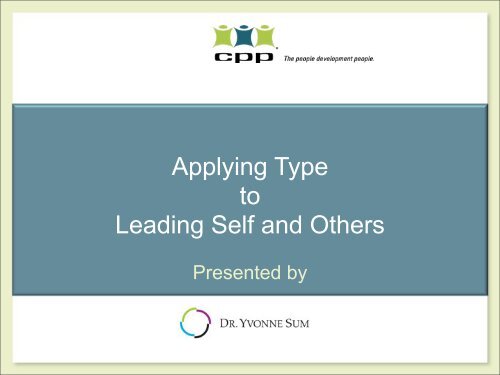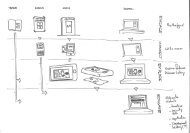Applying Type to Leading Self and Others
You also want an ePaper? Increase the reach of your titles
YUMPU automatically turns print PDFs into web optimized ePapers that Google loves.
<strong>Applying</strong> <strong>Type</strong><br />
<strong>to</strong><br />
<strong>Leading</strong> <strong>Self</strong> <strong>and</strong> <strong>Others</strong><br />
Presented by
Objectives<br />
Review your successes <strong>and</strong> challenges of using the<br />
MBTI ® Instrument<br />
Introduce 5 lenses <strong>to</strong> illustrate how <strong>to</strong> apply <strong>Type</strong> theory <strong>to</strong><br />
underst<strong>and</strong> individual <strong>and</strong> team behaviour<br />
Apply the lenses <strong>to</strong><br />
– Team strengths <strong>and</strong> development areas<br />
– Communication <strong>and</strong> Influencing<br />
– Change<br />
– Leadership<br />
– Problem Solving & Decision Making<br />
© 2011, CPP, Inc. All rights reserved<br />
2
What do you remember?<br />
What are the challenges?<br />
What are the successes?<br />
<strong>Applying</strong> MBTI <strong>to</strong> date<br />
...What do you want from this session?
The Lenses<br />
© 2011, CPP, Inc. All rights reserved<br />
4
Team <strong>Type</strong> Lens<br />
First Contact with the Team<br />
© 2011, CPP, Inc. All rights reserved<br />
5
Team analysis<br />
Record <strong>Type</strong>s on chart<br />
6
Determining Team <strong>Type</strong><br />
Total the number of individuals for<br />
each of the eight preferences<br />
The preference in each dicho<strong>to</strong>my with<br />
the higher <strong>to</strong>tal is the team preference<br />
The combination of the 4 preferences<br />
with the highest <strong>to</strong>tal is the team type<br />
With ties<br />
– Break the tie in favour of the team<br />
leadership<br />
– Break the tie in favour of noticeable<br />
organisational culture<br />
Why?<br />
Elizabeth Hirsh, Katherine W. Hirsh, <strong>and</strong> S<strong>and</strong>ra Krebs Hirsh, MBTI ® Teambuilding Program, 3rd ed. Copyright 2009 by CPP, Inc. All rights reserved. Permission is hereby granted <strong>to</strong> reproduce this document for<br />
workshop use. Duplication for any other use, including resale, is a violation of copyright law. MBTI <strong>and</strong> Introduction <strong>to</strong> <strong>Type</strong> are trademarks or registered trademarks of the MBTI Trust, Inc., in the United States <strong>and</strong><br />
other countries.<br />
© 2011, CPP, Inc. All rights reserved<br />
7
Analysing Team <strong>Type</strong><br />
1. What might this team emphasise? What positive<br />
contributions might this team make <strong>to</strong> the organisation<br />
2. What challenges might this team face? What might this<br />
team need <strong>to</strong> do <strong>to</strong> be optimally effective?<br />
3. What might this team’s leadership emphasise?<br />
4. What challenges might this team’s leadership face? What<br />
might this team’s leadership need <strong>to</strong> do <strong>to</strong> be optimally<br />
effective?<br />
Elizabeth Hirsh, Katherine W. Hirsh, <strong>and</strong> S<strong>and</strong>ra Krebs Hirsh, MBTI ® Teambuilding Program, 3rd ed. Copyright 2009 by CPP, Inc. All rights reserved. Permission is hereby granted <strong>to</strong> reproduce this document for<br />
workshop use. Duplication for any other use, including resale, is a violation of copyright law. MBTI <strong>and</strong> Introduction <strong>to</strong> <strong>Type</strong> are trademarks or registered trademarks of the MBTI Trust, Inc., in the United States <strong>and</strong><br />
other countries.<br />
© 2011, CPP, Inc. All rights reserved<br />
8
Team <strong>Type</strong> Lens<br />
Teams with <strong>Type</strong> Diversity<br />
Teams with <strong>Type</strong> Homogeneity<br />
Source: Introduction <strong>to</strong> <strong>Type</strong> <strong>and</strong> Teams, Hirsh et a (2003)<br />
© 2011, CPP, Inc. All rights reserved<br />
9
The Functions Lens<br />
Communications<br />
Influencing<br />
<strong>and</strong><br />
Persuading<br />
Selling<br />
Team Roles<br />
© 2011, CPP, Inc. All rights reserved<br />
10
Typical Characteristics of the<br />
Four Functions<br />
Characteristics<br />
STs SFs NFs NTs<br />
At their best,<br />
establish teams<br />
that are<br />
Resourceful<br />
Data oriented<br />
Friendly<br />
Service<br />
oriented<br />
Creative<br />
Development<br />
oriented<br />
Effective<br />
System<br />
oriented<br />
Team<br />
environment<br />
fosters<br />
Accountability<br />
Affiliation<br />
Personal<br />
growth<br />
Au<strong>to</strong>nomy<br />
Are energized<br />
by<br />
Marshalling<br />
resources<br />
Delivering<br />
support<br />
Offering<br />
guidance<br />
Supplying<br />
expertise<br />
Are<br />
exhausted by<br />
Inefficiency<br />
Unfriendliness<br />
In<strong>to</strong>lerance<br />
Incompetence<br />
Elizabeth Hirsh, Katherine W. Hirsh, <strong>and</strong> S<strong>and</strong>ra Krebs Hirsh, MBTI ® Teambuilding Program, 3rd ed. Copyright 2009 by CPP, Inc. All rights reserved. Permission is hereby granted <strong>to</strong> reproduce this document for<br />
workshop use. Duplication for any other use, including resale, is a violation of copyright law. MBTI <strong>and</strong> Introduction <strong>to</strong> <strong>Type</strong> are trademarks or registered trademarks of the MBTI Trust, Inc., in the United States <strong>and</strong><br />
other countries.<br />
RM 4-1<br />
11
Communication Activity<br />
Form groups of ST, SF, NF <strong>and</strong> NT types<br />
In your group discuss….<br />
1] What would someone need <strong>to</strong> say <strong>to</strong> persuade you <strong>to</strong><br />
buy an MBTI ® Training Package?<br />
What could a sales person say or do that would put you<br />
off purchasing an MBTI ® Training Package?<br />
Record your responses<br />
(Optional)<br />
2] When undertaking a project, which tasks do you seek out?<br />
Which tasks do you try <strong>and</strong> avoid?<br />
© 2011, CPP, Inc. All rights reserved<br />
12
Influencing Activity<br />
Form groups of ST, SF, NF<br />
<strong>and</strong> NT types<br />
In your group discuss….<br />
What would you need <strong>to</strong><br />
hear <strong>to</strong> be persuaded <strong>to</strong><br />
change the way you<br />
work or agree <strong>to</strong> a<br />
proposal for a new<br />
product or service?<br />
© 2011, CPP, Inc. All rights reserved<br />
Record your responses<br />
13
Writing Styles of the Four Functions<br />
ST style<br />
Short, <strong>to</strong> the point<br />
Precise, with qualifications if<br />
appropriate<br />
Bullet points<br />
Conventional words<br />
“Businesslike” <strong>to</strong>ne<br />
SF style<br />
Short<br />
Bullet points<br />
Conventional words<br />
Personal <strong>to</strong>ne, i.e., personal<br />
pronouns, specific quotes<br />
NF style<br />
Longer, paragraph format<br />
Expressive, underlining,<br />
personalized anecdotes<br />
Unique words <strong>and</strong> phrases,<br />
personal pronouns<br />
NT style<br />
Longer, paragraph format<br />
Present the “why” or logic<br />
behind the idea<br />
“Businesslike” <strong>to</strong>ne<br />
Unique words <strong>and</strong> phrases,<br />
metaphors<br />
Source: Judy Allen <strong>and</strong> Susan A. Brock, Health Care Communications Using Personality <strong>Type</strong>: Patients Are Different (Philadelphia: Routledge, 2000). Reproduced with permission.<br />
.<br />
Elizabeth Hirsh, Katherine W. Hirsh, <strong>and</strong> S<strong>and</strong>ra Krebs Hirsh, MBTI ® Teambuilding Program, 3rd ed. Copyright 2009 by CPP, Inc. All rights reserved. Permission is hereby granted <strong>to</strong><br />
reproduce this document for workshop use. Duplication for any other use, including resale, is a violation of copyright law. MBTI <strong>and</strong> Introduction <strong>to</strong> <strong>Type</strong> are trademarks or registered<br />
trademarks of the MBTI Trust, Inc., in the United States <strong>and</strong> other countries.<br />
14
<strong>Type</strong> & Communication<br />
Implications:<br />
People naturally use a<br />
communication or<br />
influencing style that<br />
suits their preferences.<br />
Underst<strong>and</strong>ing what our<br />
audience needs<br />
increases our<br />
effectiveness in<br />
communicating with<br />
them.<br />
© 2011, CPP, Inc. All rights reserved<br />
15
Team Roles & Personality <strong>Type</strong><br />
ST<br />
Technical skills<br />
with objects <strong>and</strong><br />
facts<br />
SF<br />
Practical ways of<br />
helping others<br />
NT<br />
Theoretical <strong>and</strong><br />
technical<br />
frameworks<br />
NF<br />
Insight <strong>and</strong><br />
encouraging<br />
people<br />
Source: Myers, I. (1998) Introduction <strong>to</strong> <strong>Type</strong> ®<br />
© 2011, CPP, Inc. All rights reserved<br />
16
The Quadrants Lens<br />
© 2011, CPP, Inc. All rights reserved<br />
17
Life Cycle of Organisations or New Initiative<br />
IN<br />
EN<br />
ES<br />
IS<br />
DESCRIPTOR<br />
Thoughtful<br />
innova<strong>to</strong>rs<br />
Action<br />
oriented<br />
innova<strong>to</strong>rs<br />
Action<br />
oriented<br />
realists<br />
Thoughtful<br />
realists<br />
ORGANISATION<br />
FOCUS Vision Change Results Continuity<br />
CHANGE<br />
Internal<br />
vision of<br />
future<br />
Try something<br />
novel<br />
Improve<br />
efficiency &<br />
effectiveness<br />
Can see what<br />
should<br />
change / be<br />
preserved<br />
MOTTO<br />
Let’s think<br />
about it!<br />
Let’s change<br />
it!<br />
Let’s do it !<br />
Let’s keep it!<br />
© 2011, CPP, Inc. All rights reserved<br />
Time elapsed<br />
18
Contributions & Conflict Activity<br />
Form groups of IS, ES, IN <strong>and</strong> EN<br />
types<br />
What special gifts <strong>and</strong><br />
contributions does your<br />
Quadrant bring <strong>to</strong> the team?<br />
What irritates you about the<br />
other quadrant ?<br />
What do you or could you<br />
admire about the opposite<br />
quadrant?<br />
© 2011, CPP, Inc. All rights reserved<br />
Adapted from MBTI® Team Building Program 1 st Ed (1992) by Hirsh<br />
19
Debriefing the Quadrants activity<br />
Invite one group <strong>to</strong> report their responses. Then invite the<br />
diagonal opposite group <strong>to</strong> report their responses.<br />
Ask the team how they can agree <strong>to</strong> incorporate the<br />
perspectives/contributions of all four Quadrants<br />
IS<br />
IN<br />
ES<br />
EN<br />
© 2011, CPP, Inc. All rights reserved<br />
20
Problem Solving/Conflict Resolution<br />
<strong>and</strong> the Four Quadrants<br />
When working <strong>to</strong> solve a<br />
problem, ISs tend <strong>to</strong><br />
Focus on facts that might be<br />
useful<br />
Recall past examples <strong>to</strong> guide<br />
behavior<br />
Want <strong>to</strong> determine where energy will<br />
have the best results<br />
Act sensibly<br />
When working <strong>to</strong> solve a<br />
problem, ESs tend <strong>to</strong><br />
Focus on actions that could be<br />
taken<br />
Use conventional structures <strong>to</strong> guide<br />
behavior<br />
Want <strong>to</strong> test out where effort will<br />
have the most impact<br />
Act promptly<br />
When working <strong>to</strong> solve a<br />
problem, INs tend <strong>to</strong><br />
Focus on ideas that might be<br />
applicable<br />
Anticipate potential problems <strong>to</strong><br />
guide behavior<br />
Want <strong>to</strong> underst<strong>and</strong> where energy<br />
will have the best results<br />
Act prudently<br />
When working <strong>to</strong> solve a<br />
problem, ENs tend <strong>to</strong><br />
Focus on changes that could be<br />
made<br />
Invent novel frameworks <strong>to</strong> guide<br />
behavior<br />
Want <strong>to</strong> speculate on where effort<br />
will have the most impact<br />
Act enthusiastically<br />
Elizabeth Hirsh, Katherine W. Hirsh, <strong>and</strong> S<strong>and</strong>ra Krebs Hirsh, MBTI ® Teambuilding Program, 3rd ed. Copyright 2009 by CPP, Inc. All rights reserved. Permission is hereby granted <strong>to</strong><br />
reproduce this document for workshop use. Duplication for any other use, including resale, is a violation of copyright law. MBTI <strong>and</strong> Introduction <strong>to</strong> <strong>Type</strong> are trademarks or registered<br />
trademarks of the MBTI Trust, Inc., in the United States <strong>and</strong> other countries.<br />
RM 4-19<br />
21
Change <strong>and</strong> the<br />
Four Quadrants<br />
Ways <strong>to</strong> introduce change <strong>to</strong> ISs<br />
Relate it <strong>to</strong> what they know<br />
Give them a detailed picture of the<br />
change<br />
Emphasize the connection with what<br />
is known <strong>and</strong> unders<strong>to</strong>od<br />
Show them how it can make a<br />
tangible, lasting difference in their<br />
work<br />
Ways <strong>to</strong> introduce change <strong>to</strong> ESs<br />
Relate it <strong>to</strong> what they can do<br />
Give them a realistic rationale for<br />
the change<br />
Emphasize the connection with<br />
current procedures<br />
Show them how it can make their<br />
work more efficient <strong>and</strong> easier<br />
Ways <strong>to</strong> introduce change <strong>to</strong> INs<br />
Relate it <strong>to</strong> innovative concepts<br />
Give them the underlying<br />
significance of the change<br />
Emphasize the possibilities for<br />
creativity<br />
Show them how it can bring their<br />
work closer <strong>to</strong> the ideal<br />
Ways <strong>to</strong> introduce change <strong>to</strong> ENs<br />
Relate it <strong>to</strong> inventive ways of doing<br />
things<br />
Give them a broad overview of the<br />
change<br />
Emphasize the possibilities for<br />
variety<br />
Show them how it can make their<br />
work pioneering <strong>and</strong> fresh<br />
Elizabeth Hirsh, Katherine W. Hirsh, <strong>and</strong> S<strong>and</strong>ra Krebs Hirsh, MBTI ® Teambuilding Program, 3rd ed. Copyright 2009 by CPP, Inc. All rights reserved. Permission is hereby granted <strong>to</strong> reproduce this document for workshop use.<br />
Duplication for any other use, including resale, is a violation of copyright law. MBTI <strong>and</strong> Introduction <strong>to</strong> <strong>Type</strong> are trademarks or registered trademarks of the MBTI Trust, Inc., in the United States <strong>and</strong> other countries.<br />
RM 4-18<br />
22
The Dynamics Lens<br />
Order of<br />
Preferences;<br />
Dominant<br />
Auxillary<br />
Tertiary<br />
Inferior<br />
© 2011, CPP, Inc. All rights reserved<br />
23
The Dynamics Lens<br />
Provide team participants with a brief overview of type<br />
dynamics by presenting the following:<br />
– Each personality type has a favourite or most trusted<br />
preference - Dominant Preference<br />
– There is a hierarchy of preferences for each type - see<br />
Introduction To <strong>Type</strong> ® <strong>and</strong> Teams booklet pages 47-48<br />
© 2011, CPP, Inc. All rights reserved<br />
24
Dominant Preferences in the <strong>Type</strong> Table<br />
1 st row: 2 nd letter<br />
ISTJ ISFJ INFJ INTJ<br />
2 nd row: 3 rd letter<br />
ISTP ISFP INFP INTP<br />
ESTP ESFP ENFP ENTP<br />
3 rd row: 2 nd letter<br />
ESTJ ESFJ ENFJ ENTJ<br />
4 th row: 3 rd letter<br />
© 2011, CPP, Inc. All rights reserved<br />
25
Activity Scenario<br />
Your work office will need <strong>to</strong><br />
relocate from a capital city <strong>to</strong><br />
a smaller <strong>to</strong>wn. What would<br />
be the first things your group<br />
would consider <strong>to</strong> implement<br />
this decision?<br />
Start with your Dominant<br />
preference group then move<br />
<strong>to</strong> the next preferences<br />
according <strong>to</strong> the time<br />
allocated.<br />
© 2011, CPP, Inc. All rights reserved<br />
26
Decision Making Process for Team<br />
Problem-Solving Model<br />
Model from Gordon Lawrence, People <strong>Type</strong> <strong>and</strong> Tiger Stripes (Gainesville, FL:CAPT, 1982), p.58.<br />
SENSING<br />
(FACTS)<br />
INTUITION<br />
(POSSIBILITIES)<br />
THINKING<br />
(CONSEQUENCES)<br />
FEELING<br />
(IMPACT ON PEOPLE)<br />
Using the Myers-Briggs <strong>Type</strong> Indication in Organizations (2 nd edition) by S<strong>and</strong>ra Krebs Hirsh. © 1991 by Consulting Psychologists Press, Inc. Permission is herby granted <strong>to</strong> reproduce this<br />
worksheet for workshop use. Duplication for any other use, including resale, is a violation of the copyright law.<br />
© 2011, CPP, Inc. All rights reserved<br />
27
Problem Solving <strong>and</strong> the Four<br />
Dominants<br />
Sensing Dominants are likely <strong>to</strong><br />
ask<br />
How is the problem defined?<br />
What are the current procedures?<br />
What are our specific goals?<br />
What are the immediate objectives<br />
<strong>and</strong> how can timelines be<br />
established?<br />
Thinking Dominants are likely <strong>to</strong><br />
ask<br />
Is this a legitimate issue?<br />
How does it affect performance?<br />
What are the pros <strong>and</strong> cons?<br />
How can we look at this<br />
systematically?<br />
Intuitive Dominants are likely <strong>to</strong><br />
ask<br />
What alternatives are there?<br />
How is this issue related <strong>to</strong> wider<br />
concerns?<br />
What are the opportunities for<br />
growth?<br />
What are our hunches about this<br />
issue?<br />
Feeling Dominants are likely <strong>to</strong><br />
ask<br />
What are people’s feelings about this<br />
issue?<br />
How can different sides be<br />
accommodated?<br />
What will increase harmony?<br />
How will this affect the people<br />
concerned?<br />
Elizabeth Hirsh, Katherine W. Hirsh, <strong>and</strong> S<strong>and</strong>ra Krebs Hirsh, MBTI ® Teambuilding Program, 3rd ed. Copyright 2009 by CPP, Inc. All rights reserved. Permission is hereby granted <strong>to</strong> reproduce this document for workshop use. Duplication for any other<br />
use, including resale, is a violation of copyright law. MBTI <strong>and</strong> Introduction <strong>to</strong> <strong>Type</strong> are trademarks or registered trademarks of the MBTI Trust, Inc., in the United States <strong>and</strong> other countries.<br />
RM 4-45<br />
28
MBTI Leadership Poster<br />
<strong>Type</strong> __________<br />
As leaders . . .<br />
Contributions<br />
Overdo<br />
Overlook<br />
What do you need<br />
<strong>to</strong> be your best<br />
What others do that<br />
annoys you<br />
Mot<strong>to</strong>:<br />
29
Follow-up Group Coaching<br />
45 minutes X 2 ?<br />
90 minutes X 1 ?<br />
When ?<br />
30
Resource Materials -Teams & Leadership<br />
<br />
<br />
<br />
<br />
<br />
<br />
<br />
<br />
<br />
Introduction <strong>to</strong> <strong>Type</strong> ® <strong>and</strong> Teams<br />
MBTI ® Teambuilding Program Leaders Resource Guide<br />
Introduction <strong>to</strong> <strong>Type</strong> ® in Organizations<br />
Introduction <strong>to</strong> <strong>Type</strong> ® <strong>and</strong> Decision Making<br />
The Leadership Advantage – Training Program<br />
Using the MBTI ® Tool in Organizations – Leaders Resource Guide<br />
Developing Leaders – Research & Applications in Psychological <strong>Type</strong><br />
Enhancing Leadership Through Psychological <strong>Type</strong><br />
Teamwork from the Inside Out – Field book<br />
31
Thank You<br />
www.cpp.com<br />
MBTI, Myers-Briggs <strong>Type</strong> Indica<strong>to</strong>r, Myers-Briggs, the MBTI logo <strong>and</strong> Introduction <strong>to</strong> <strong>Type</strong> are registered trademarks of the Myers-Briggs <strong>Type</strong> Indica<strong>to</strong>r Trust. SkillsOne <strong>and</strong> the<br />
CPP logo are registered trademarks of CPP, Inc.<br />
© 2009, CPP, Inc. All rights reserved 32 96




